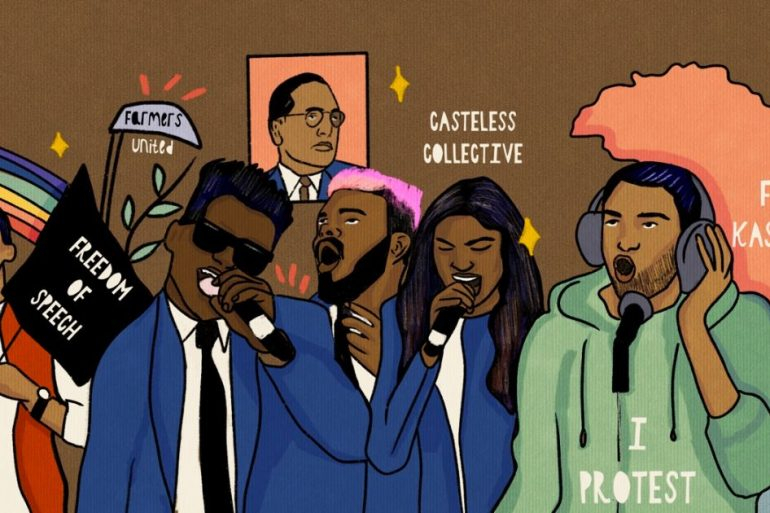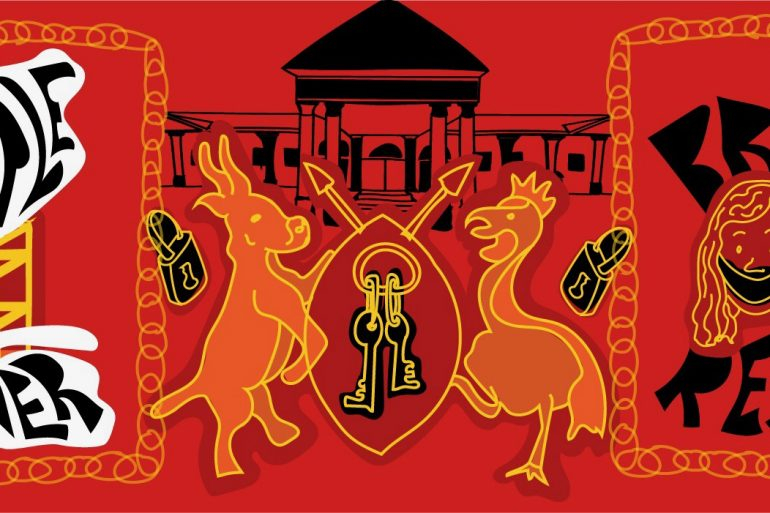We came across the incredible work of Sudanese artist Alaa Satir before we’d even officially launched shado and were so excited to finally meet her now that she’s studying in London. Last December (almost to the day), when the revolution began in Sudan, Alaa was one of the first of many women at the forefront of the uprisings, using art as her method of resistance. Based in Khartoum, Alaa’s work started in sketchbooks and ended up as large murals in the centre of the city; at the very site of the public uprising. “A woman’s place is in the resistance” became the soundtrack to the revolution and also to Alaa’s artwork.
We were honoured to then feature Alaa in our second print edition of shado, with a bio written by her brilliant sister Enas, also an artist, based in Toronto. She wrote about Alaa in words that encapsulated her perfectly:
“I believe all the effort Alaa has been putting into her work has been building to this moment, when the world can finally see what she is about. It is a time that a country is tested, and it makes perfect sense to me that Alaa is now finally having her moment in time.”

What does change look like in your industry?
I’m familiar with the challenges I faced as an artist in Sudan – and in Khartoum more specifically – and the changes that need to be done in that environment. Yes, there are a lot of challenges, but I think it all comes down to one big challenge: how art and artists are being perceived in society. The structure of society and the education system in Sudan is not made for artists to thrive, or even realise their talent. The fact that your family; your friends; the people around you have a very narrow idea of what success is – and being an artist is not part of that definition – makes you, as an artist, face a lot of time before you realise that this is what you need to do. All of us, as a collective, need to do better when it comes to giving art and artists their true value. Our idea of success as being a doctor or an engineer; of doing that with your life – we need to expand that definition more. It should include anyone who wants to follow their passion. We have to realise that we are different, and we have different abilities, and we can contribute to building the society in different ways. We need to realise how art can be powerful. That’s the main challenge that we have.
What changes are you contributing to in your work?
I never try to measure if I’m making any sort of changes, or if what I do actually changes anything. I’m not even sure it can be measured – maybe the changes are not very visible for me. But, I know that it might be normal, with art, that you can’t see the changes in a very visible manner.
My work is basically an extension of my experience; me trying to figure things out for myself. I’m trying to make sense of things; sometimes, I’m trying to make fun of the sort of challenges that come with being a woman, or being Black, or being Sudanese. Some people might find themselves in these artworks.
If you feel any sort of feeling looking at one of my artworks: if it makes you happy, if it makes you sad, if it makes you think, or if it makes you look at things a bit differently – this, for me, is a change.

What are some of your biggest successes in 2019?
I think 2019, to say the least, was one of the most complex years of my life. It had one of my highest moments, but also some of my very lowest moments. It’s easier for me to pinpoint my biggest success, though – and it must be the time that I drew my first mural. This is for a lot of reasons. It was the 10th of April, during the revolution; it was the day before the fall of Omar Al-Bashir.
Written in the mural was a very feminist message. I didn’t come up with this message; it was something that was shouted in the protests by the women leading them. We had this chant which said, “ladies, hold your ground: this is a woman’s revolution.” It was just very clear to me that my first mural had to have that chant in it.
For the longest time, street art and artists have been a huge source of inspiration for me. This is one of the major reasons that I got into art in the first place. I was captivated by the kind of courage that it takes to put your work out into the street for everyone to see. Not a very long time ago, I was the kind of person who would get nervous if I was sketching something and you would look over my shoulder – and, not long before that, I was the kind of person who wouldn’t even show my work to anyone. So, the idea of putting one’s work out there very fearlessly is something that I was always fascinated by.
The streets belong to everyone, so the art belongs to everyone
– you don’t have to go to some fancy exhibition, or be part of some elite group of people, to be able to have access to that work. It’s for everyone to see. It must have the biggest audience, or at least the most diverse audience; young people to old people; people from different backgrounds; they can all have access to your work if it’s out on the street. I’ve been following street artists for a long time, and I’ve been tracking how the street art movement has been evolving. I always wanted to be part of it.
Before 2019 started, and before the Sudanese revolution started, I had that one resolution of making one art mural in this year. I’m not a ‘New Year, New Me’ kind of person, but that was one goal that I really wanted to achieve. I told myself, even if it ended up being my bedroom wall, I’m just gonna draw something on a bigger scale than my sketchbook – just to break that fear barrier. So, the fact that I drew my mural in a place that’s iconic as the grounds that held the Sudanese revolution for all of these months – it meant so much to me. I didn’t know that I would end up drawing 9 or 10 murals that year. I think that was one of my highest moments, and I believe it helped me to develop my artistic language. I think my style is coming to life more, and this year I have developed the elements that make my work different. The colours I use, and the patterns – I’m getting to know myself a bit more, and my language as an artist is starting to become much clearer.
What is the importance of grassroots activism in implementing change at a higher/broader level?
I think this year has proved that grassroots activism is not just important, but highly effective. With all the movements that we witnessed this year that started from a grassroots level, we can see that, even though most of them didn’t reach their end goal, they proved that they were very much capable of shaking the system.
Activism comes from a very pure place of wanting to make change happen: nothing else.
These grassroots movements comprise of people who are as different as they can be, but they’re capable of mobilising and organising within themselves towards a common goal. The fact that they are affected the most by the system means they carry with them this resilience and determination to make sure that this goal is being worked towards.
Subscribe to shado's weekly newsletter
Exclusive event news, job and creative opportunities, first access to tickets and – just in case you missed them – our picks of the week, from inside shado and out.

Dictatorship systems and governments have realised the power in grassroots organisation; this kind of activism is highly effective, and can really threaten their authority. That is why they make sure that it doesn’t exist, or they make sure the people are silenced for as long as possible. They eliminate any source of freedom of speech, and silence opinions that are slightly different to the common idea that they allow. Because of this, it takes a long time for the people to have their voice. Sudan is a very good example of that. The government knows how powerful your voice can be, so they try to mute it for as long as possible.

What are you excited for in 2020?
I would say that it’s the same goal as each year: to try to come up with more content; to develop my artistic language and reach more people with my work. I’ll continue trying to answer the ultimate question: is my art capable of making any sort of change happen? Finding the answer to that question only comes with unlocking new stages of my work, and pushing myself out of my comfort zone; pushing my work towards a new stage that is going to make me realise something different, and something new that I didn’t know. Learning while I’m working; about my work; about myself; about the people around me; about the society that I live in… everything.


See more of Sali’s photography on her instagram
Interview carried out by Hannah Robathan and Isabella Pearce, co-founders of shado














